Super-Heated Plasma In Left Wing?
The Columbia investigation board Friday continued to
zero in on what bored a hole in the shuttle's aluminum skin - a
hole that apparently allowed super-hot gases to penetrate the wing
and destroy the orbiter.
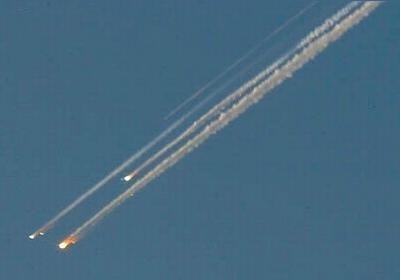
The investigators have said that a gash or some other kind of
breach probably doomed the spacecraft.
Columbia broke up in the sky over Texas, killing its crew of
seven and leaving a trail of debris from Texas to Louisiana.
Debris In New Mexico?
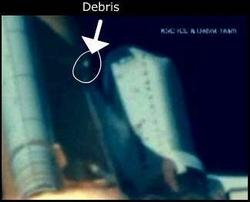 No debris has been found west of Texas, although
New Mexico Gov. Bill Richardson said Friday that NASA believed a
piece of space shuttle wing might have fallen in the Sandia
Mountains there. A search was planned for Saturday.
No debris has been found west of Texas, although
New Mexico Gov. Bill Richardson said Friday that NASA believed a
piece of space shuttle wing might have fallen in the Sandia
Mountains there. A search was planned for Saturday.
Meanwhile, the board is analyzing various possible causes for
the breach. One possibility, raised from the very start of the
investigation, is that the shuttle was damaged by a hard piece of
foam insulation that fell off the external fuel tank during liftoff
(right).
On Friday, flight director Leroy Cain said that the foam debris
immediately came to mind on Feb. 1 during the shuttle's final
moments when he was first told of sensors breaking down in the
spacecraft's left wing as it glided toward home.
"That gave me pause. That was the first time I had thought about
that debris hit we took on ascent," Cain said. But he said that
when he learned about the sensor readings, he did not imagine that
it would spell the end for the shuttle and its crew: "I did not
think that we would lose it."
As for other possible causes of the damage, not even sabotage
has been ruled out, investigation board chairman Adm. Harold Gehman
Jr. said.
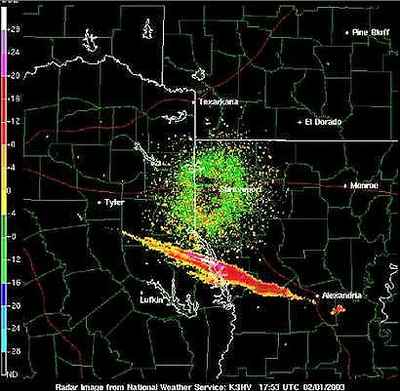
"Any purposeful hindrance or damage is included in our
investigation just like everything else," he said. "Everything is
on the table."
George J. Gleghorn, a retired TRW Inc. engineer and former
member of the NASA Aerospace Safety Advisory Panel, said it is
unlikely a piece of debris or meteoroid struck Columbia during its
16-day mission without anyone noticing.
That leaves liftoff as the most likely time for a breach to have
occurred, said Gleghorn, a space debris expert.
"I would be surprised if something happened that caused a breach
of the skin without being noticed unless it was that incident that
happened during the ascent phase," Gleghorn said.
Investigators believe the breach allowed a stream of superheated
gases to penetrate the shuttle's left wing, starting a cascade of
failures.
One by one, sensors embedded throughout Columbia's left wing
began recording unusual readings as the shuttle approached the
California coast on Feb. 1. The precise meaning of those readings
was not immediately clear to Mission Control, Cain said.
The wings have only a few sensors, not enough to confirm in real
time whether the landing gear hatch had come open or had been
breached to allow the superheated gases, called plasma, to
penetrate the wing, he added.
Seven minutes after the first indication of a problem, Columbia
broke apart.
Temperature Spikes
Most ominous of the readings was a spike in temperature in the
compartment containing Columbia's left landing gear that suggests
gases 2,000 degrees or hotter had infiltrated the shuttle. To do
so, they would have had to bypass the layer of tiles and other
insulating material designed to protect the spacecraft from the
searing heat of re-entry.
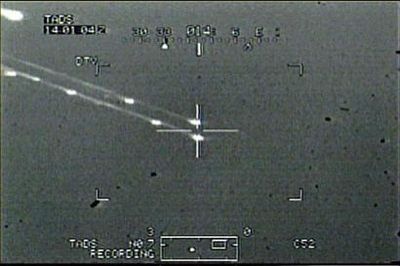
The investigation board has ruled out the possibility that a
missing tile would have allowed heat to simply radiate into the
interior of the wing and cause the rise in temperature. That leaves
the theory that a breach of some kind allowed the gases to stream
in directly.
The location of the sensors that gave unusual readings, as well
as the nature and timing of the readings, should allow the
investigation to reconstruct the chain of events.
In Mission Control, it took minutes for the flight team to
realize what had happened to Columbia. It was reports from the
field, including TV images, that confirmed for the flight team that
the mission had ended in disaster, Cain said.
"All we knew was we had a significant event that was probably
catastrophic," Cain said. He said he recited a prayer for the
crew and their families and shed a tear before continuing with the
grim business of the day.
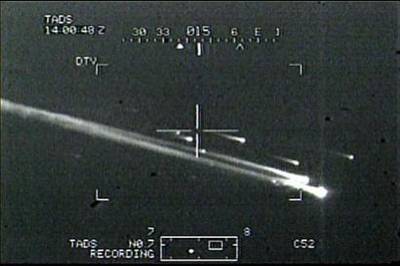
"The kind of problem that we suffered on this day, there isn't
anything to my estimation that the flight team could have or should
have done differently," Cain said.
On Friday, the board traveled from Kennedy Space Center at Cape
Canaveral, Fla., to the Marshall Space Flight Center in Huntsville,
Ala., where the members planned to learn more about the shuttle,
including the tank insulation.
Gehman said he will add one or two authorities in high-altitude
aerodynamics and thermal engineering to the nine-member board to
bring more expertise to the investigation. The board will also
conduct some key tests independently of NASA, he said.
"We're not going to double-check everything NASA does," Gehman
said. "NASA is a great organization and we have no doubts about
their competence. But when something bears directly on our report
... we will go out and get that technically and independently
verified."
The board has been criticized by members of Congress and others
as not being sufficiently independent of NASA.
Search crews continued to comb Texas and Louisiana for more
debris from Columbia. Remains of all seven astronauts have been
recovered. They are being analyzed for clues about Columbia's
destruction, Gehman said.
 NASA is also seeking more images of Columbia's
re-entry, including any pictures taken from aboard ships that were
between Hawaii and California on Feb. 1. It wants to stitch
together photographs, videotapes and other information to
reconstruct Columbia's final minutes. Some of the most explicit,
telling photographs were released on Friday. They were shot by a
Dutch Apache helicopter on training maneuvers at Ft. Hood (TX).
NASA officials said the photographs were very valuable and are now
being studied at the Johnson Space Center in Houston (TX).
NASA is also seeking more images of Columbia's
re-entry, including any pictures taken from aboard ships that were
between Hawaii and California on Feb. 1. It wants to stitch
together photographs, videotapes and other information to
reconstruct Columbia's final minutes. Some of the most explicit,
telling photographs were released on Friday. They were shot by a
Dutch Apache helicopter on training maneuvers at Ft. Hood (TX).
NASA officials said the photographs were very valuable and are now
being studied at the Johnson Space Center in Houston (TX).
Also on Friday, NASA released edited footage shot inside Mission
Control during the disaster. It includes an image of Cain
(right) with a tear coursing down his left cheek as he
organized the response of his team.
 Classic Aero-TV: The Switchblade Flying Car FLIES!
Classic Aero-TV: The Switchblade Flying Car FLIES! ANN FAQ: Q&A 101
ANN FAQ: Q&A 101 ANN's Daily Aero-Term (04.12.24): Discrete Code
ANN's Daily Aero-Term (04.12.24): Discrete Code ANN's Daily Aero-Term (04.13.24): Beyond Visual Line Of Sight (BVLOS)
ANN's Daily Aero-Term (04.13.24): Beyond Visual Line Of Sight (BVLOS) ANN's Daily Aero-Linx (04.13.24)
ANN's Daily Aero-Linx (04.13.24)








